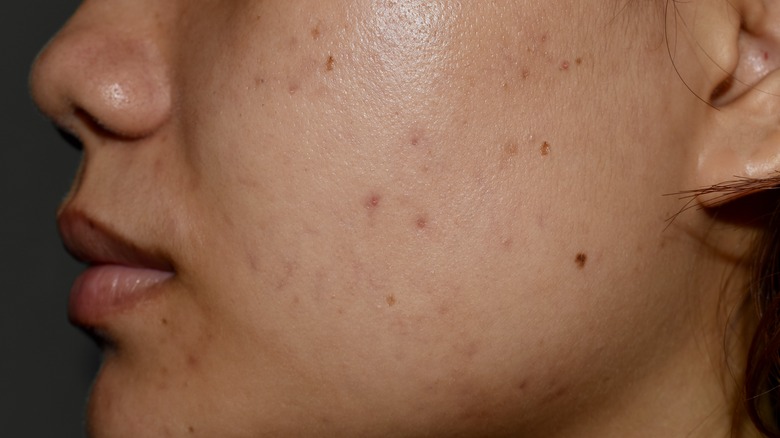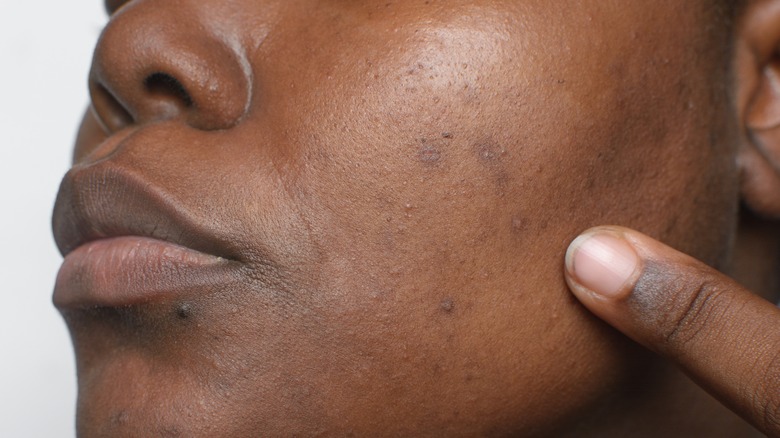Your Guide To The Different Types Of Skin Hyperpigmentation
You probably already know that hyperpigmentation is patches of discolored skin, and you probably also know that it's pretty common. According to Skin Ingredients, as many as 40% of people will experience some kind of hyperpigmentation in their lives, with most people developing visible marks sometime in their 30s or 40s.
One thing you may not know about hyperpigmentation, though, is that there's not just one kind out there. Though the results may look similar on the skin, hyperpigmentation is actually an umbrella term for any darkening of the skin, with three prominent types: age spots, melasma, or post-inflammatory hyperpigmentation. And we're breaking down exactly what each one is and what you need to know about them, from how they develop to the best treatments. Just remember that you should never feel pressured to remove any hyperpigmentation from your skin, as it can actually be beautiful and totally unique in its own way.
Age spots are caused by sun exposure
Age spots (aka liver spots, sunspots, or solar lentigines) are one of the most well-known types of hyperpigmentation. They typically show up as rounded, darkened patches of skin roughly the size of a poppyseed or freckle. Normally, they're caused by prolonged sun exposure, which is why they're common on exposed areas of the body, like the face and hands. Just another reason why it's so important to apply SPF every single day!
But, despite being related to sun exposure, age spots aren't harmful, and shouldn't cause a person any pain. However, many people treat them to achieve a more even skin tone. Age spots can be particularly visible on light skin, with Medscape claiming as many as 90% of the white population in the U.S. aged 60 or over experience them. It's also thought to occur in 20% of white Americans aged 35 or younger.
For those who wish to fade their age spots, the American Association of Dermatology suggests laser treatments, which work by targeting the pigment and dispersing it. Cryosurgery is another treatment that works by freezing the area so the skin can heal more evenly. Some people also turn to microdermabrasion or chemical peels to resurface the skin. If you're not looking for something quite as invasive, board-certified dermatologist Dr. Alexis Stephens told Vogue that opting for skincare products that contain antioxidants can help. Retin-A or Retinol can also have an exfoliating effect for a more even complexion.
Melasma is particularly prevalent in pregnant women
Melasma may resemble age spots in that it can show up as light brown, dark brown, or blue-y gray spots on the skin; however, it typically occurs in slightly larger patches rather than speckles. Although sun exposure plays a factor, melasma is thought to be caused by hormonal changes that impact melanocytes, which produce our skin's melanin. This is why pregnant women are commonly affected by the condition. In addition to pregnancy, certain birth control pills, medications, or even genetics can be a risk factor.
Here's where things can get a little more complicated though, as there are three different types of melasma. Epidermal is dark brown and defined, dermal is more on the light brown or even blue side and has less defined edges, while mixed melasma tends to be a mixture of both brown and blue pigments.
Though there's currently no definitive cure for melasma, there are treatment options out there. Similar to age spot treatments, the British Skin Foundation recommends chemical peels and laser treatments, in addition to microneedling, as that can help lighten the skin by encouraging collagen production. It also suggests trying skin lightening creams, but it's important to always speak to a professional first.
Post-inflammatory hyperpigmentation is the result of pre-existing skin conditions
The third and final type of hyperpigmentation is known as post-inflammatory hyperpigmentation. This refers to any darker patches of skin that have developed as a result of a skin condition that injured the skin, which resulted in it creating more melanin as a result. The most common of these, per the National Library of Medicine, can include hyperpigmentation caused by acne flare-ups (known as post-acne hyperpigmentation), atopic dermatitis (which is a type of eczema), and impetigo. But that's not all. Past infections, burns, bug bites, allergic reactions, rashes, and psoriasis can also be behind this kind of hyperpigmentation. Similar to the other types though, post-inflammatory hyperpigmentation shows up on the skin as light brown, dark brown and blue-gray patches or spots on the skin.
Treating this kind of hyperpigmentation is actually pretty similar to the other types we've covered. WebMD recommends chemical peels to renew the skin as well as topical treatments to even out the skin. That may include lightening products to even the skin tone, or hydroquinone and azelaic acid which can help with excess melanin production. Retinoids may also help fade hyperpigmentation marks due to their anti-inflammatory properties.
But, again, you should always see a professional before trying anything new on your skin. A doctor or dermatologist will be able to tell you exactly what type of hyperpigmentation you have and will be able to recommend personalized treatment for the very best results.



